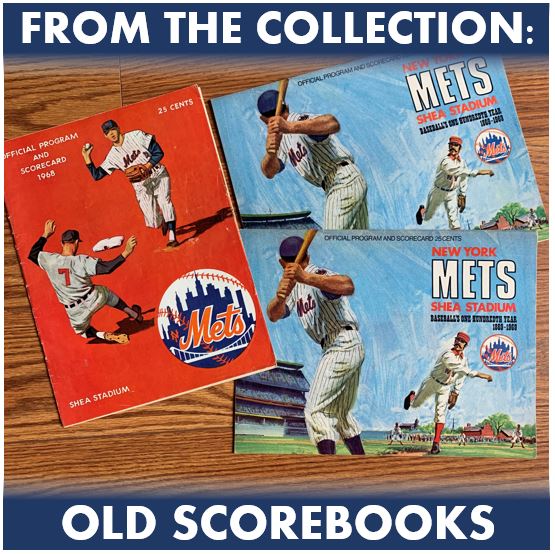
I haven’t posted about other parts of my collection outside of my cards in a while. My neighbor Sean (@seansportscards on IG – give him a follow) posted an old All-Star program he got and I figured I had to dig something out too. This was something I got from my family last year. As you might remember from other posts I’ve done like this, my family will sometimes find things at their houses or my grandmother’s house and pass it along to me if its sports related.
This find was three old scorebooks from Mets game of the late ’60s. More specifically, one from 1968 and two from 1969. In general they are interesting, but there are so many aspects of them that are cool other than them just being old. The adds, the prices, the way they lay everything out, and my favorite part… my grandfather’s scorekeeping!
I don’t know how many out there who had Dads or Granddads that kept score and taught you about it, but it was my Granddad for me. He was meticulous about a lot of things and keeping score at a game was one of those things. He taught me how he did it and I will still do it to this day, although not for every game. These days it does tend to feel tedious because of all the changes in a game.
I hope you enjoy these as much as I do.
Thursday, July 4, 1968
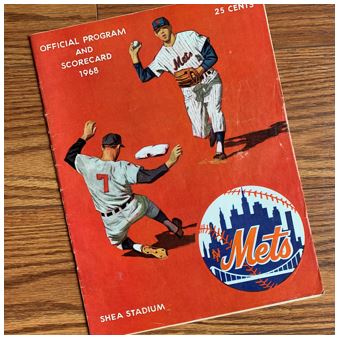
The first “Official Program and Scorecard” is from Thursday, July 4, 1969. I think these days they changed them up every few series, but I’m not sure what they did back then. It could be that most of it stayed the same, but I noticed the rosters are next to the scoring so they obviously have to change that at least for each series.
The design on this one is a bit sparse but the drawings are definitely of that era. For that matter so is the font. Oh, and the price! We’ll get into the more later, but 25 cents for what you’ll find in here seems crazy. Now, you could argue that they give these things away now (at least they used to – who knows about now), but they just don’t seem the same.
Another thing I appreciate, the Mets logo hasn’t changed all that much. Sure, they may put some little tweaks on it, but I actually love that’s it’s stayed the same through all these years.
Content Is King
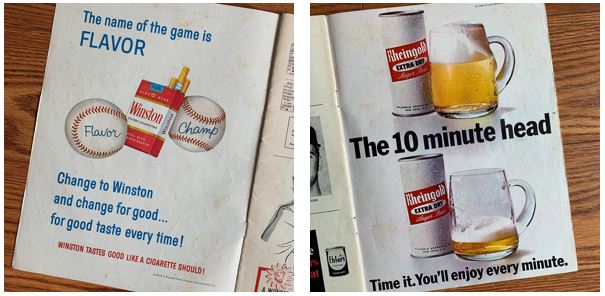
One of the first things that overwhelms you about so many pages are the advertisements for Alcohol, which isn’t necessarily strange these days, but also cigarettes. That’s the one that really gets me. It’s the way they talk about the “taste” or “flavor” and all that. I’ve never smoked, but damn did they try to really SELL this stuff back then. Makes you think so differently about it now.
The Rheingold add is classic for how much Rheingold and the Mets went together back in those days.

As for the more substantial content (ignoring the other bits of alcohol and cigarette adds you can catch in these pictures) are the articles and information they have about the players and all the logistics of the stadium. On of my favorite parts is when they quoted manager Wes Westrum in Spring Training of ’67 stating that Tom Seaver could be “a possible spot starter and long relief man.” But it does close with “Tom Seaver is no longer the best pitching prospect in the Mets’ organization. He’s the best pitcher.”
The price scale for 1968 home games was $3.50 for Box Seats and $2.50 for Reserved Seats. You could actually buy tickets at Grand Central Terminal, Manufacturers Hanover Trust, and Macy’s.
OK, time to get to the game! This was the second game of a doubleheader on July 4th, 1968. The Mets were 37-41 and would end the year at 73-89. The game was played in 2 hours and 32 minutes and there were 29,587 people in attendance. I don’t have a scorecard for the first game, but on Baseball Reference this was listed as a day game.
While I don’t know the circumstances, my guess would be that my great aunt was at this game. She loved baseball and her favorite team was the Pirates. She would take my Aunt (Dad’s sister) down to Spring Training to see the Mets and the Pirates. So I would bet anything that she would have been there as well.
Pittsburgh – 3
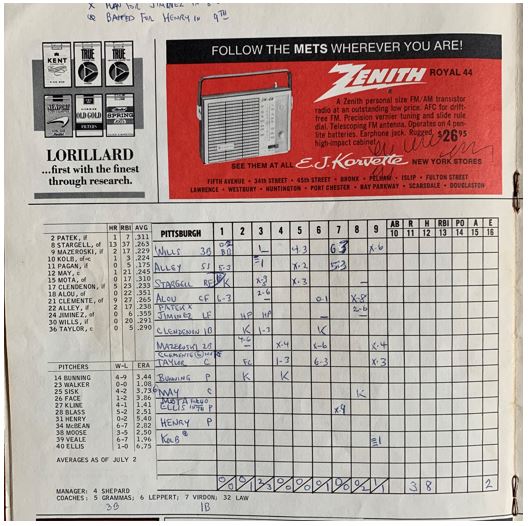
The first thing I noticed is outside the scorecard itself. The top of the page is where my Granddad made a note about how Patek was a pinch runner and Kolb was batting for the pitcher. That’s something I hate thinking about in scorecards these days. The other thing I noticed like that was that he noted what base the coaches were used at.
More generally about the scorecard I was noticing the stats on the side. Steve Blass was pretty good to that point, but Doc Ellis was 1-0 with a 6.75 ERA. Willie Stargell was batting .263 with 13 homers and 37 RBI and Donn Clendenon was on the roster, but would be a Met via trade in 1969.
But the Mets held the Bucs to three runs so let’s see how it turned out for them.
Mets – 4 (Winner!)
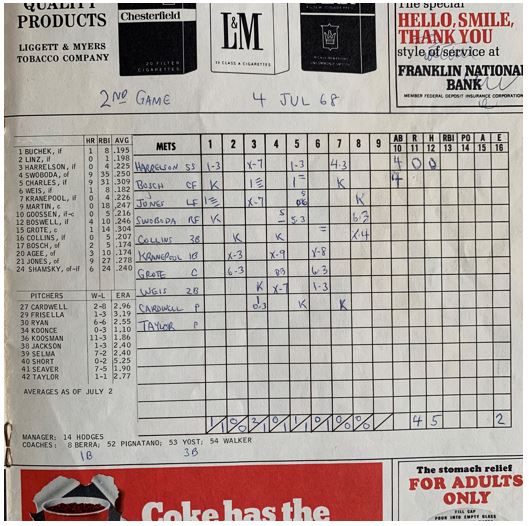
Winner, Winner, Chicken Dinner!
The Mets score four runs on homers by Cleon Jones and the centerfielder Don Bosch. Speaking of “CF”, do you notice how in the roster on the left they are only designated as “if” or “of” unless they are a catcher? Don Cardwell scattered the seven hits he gave up and they pulled out a win over Jim Bunning.
Wednesday, April 23, 1969 and Friday, May 30, 1969
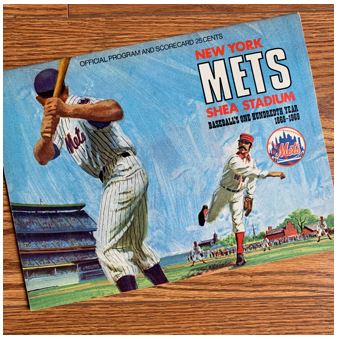
The design for the next two from 1969 were the same and given it was “Baseball’s One Hundreth Year 1869-1969” it featured the modern Mets player hitting with Shea in the background on the left half of the picture with the old-timey New York player in a field on pitching on the right. There are a bunch of fonts on the pages which is very different to the year before. But I really like this and it’s a clever piece of art.
Content, Content, Content

Again the ads are just great. The style of the “hula girl” is amazing but I really don’t have any idea what that has to do with a Chevron ad. There is a line that says “exciting as a beat of native drums” so who knows. There was a Chevron ad in the year before as well but it was a different design. You also see another Rheingold ad and this time it features cartoons from the great Bill Gallo (those used to be my favorite to get to as a kid).
The middle page is interesting. It’s basically a “see who we’ll be playing” type of thing with Aaron, Rose, Flood, Holtzman, and Mazeroski on the page. I kind of wondered if this was put in as a way to draw people because they didn’t think they would be good. I mean, they hadn’t up to that point so it would make sense.
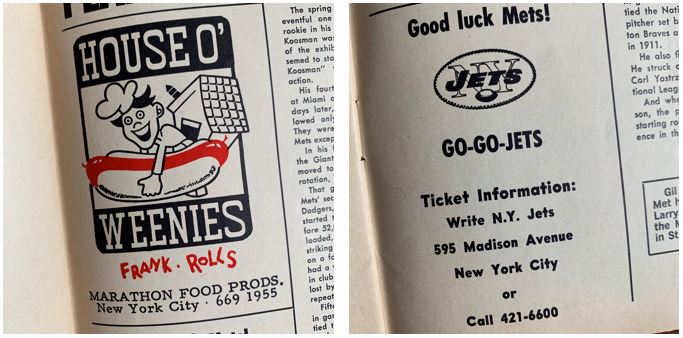
These were just little ads, but they were my favorite. How could you not want to visit the House O’ Weenies!? I think I might need to take a road trip. And the “Go-Go-Jets” ad is great too. You would think it would be a little bit bigger from the Jets standpoint. They’d just won Super Bowl III earlier that year!
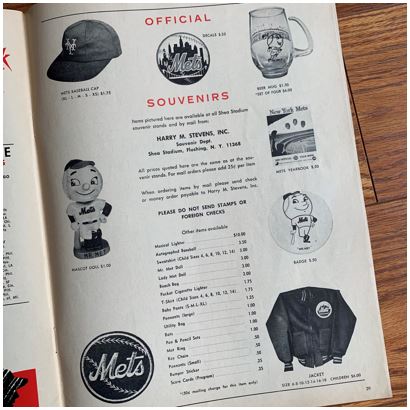
The prices on the souvenirs are truly amazing. I think my favorites are:
- Musical Lighter $10 – WTF is that?
- Sweatshirt $3 – Really?
- Lady Met Doll $3 – Oh, it’s a lady…
- Pocket Cigarette Lighter $1.75 – We are at two on the lighter count…
- Jacket $6 – Another REALLY!?
So much great stuff.
We have two different games to cover. The first is April 23, 1969 against the Pirates.
Mets 2, Pirates 0
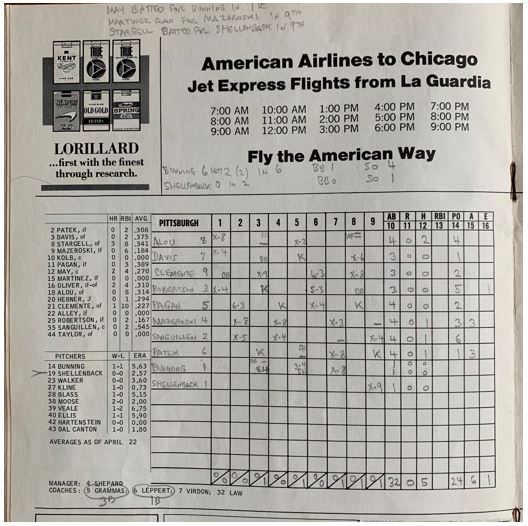
Look at the details my Granddad kept on this page. We’ve got his notes for the changes at the top and then a little recap on the pitchers as well there. He also noted where the coaches were.
Jerry Koosman shut out the Pirates in this one, so let’s see how the Mets fared.
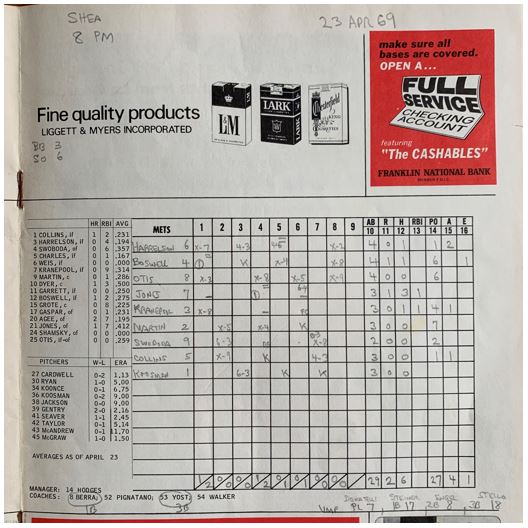
The Mets backed Koosman up with five runs. As you can see Cleon jones went 3 for 3 with an RBI and a run score.
Now for my favorite Granddad detail… he kept track of the umpires and where they were on the field.
Mets 4, Giants 3
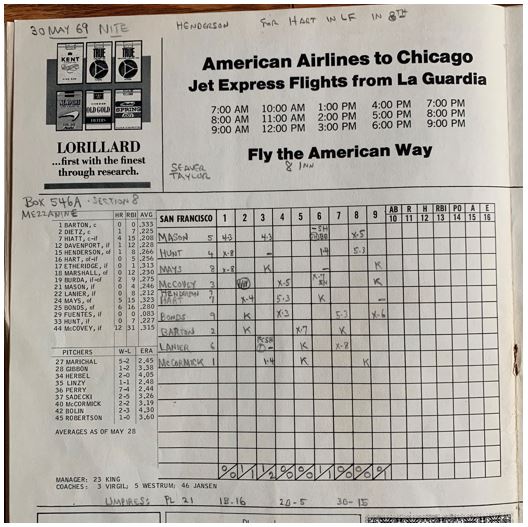
The last game here is the Mets against the Giants on May 30, 1969. According to his notes it was at “Nite.” He even kept a note as to where he sat this time around. And the notes on the umpires are back as well. He’s got all that detail but he didn’t end up filling in all the totals at the end for either team. You can see that the Giants had three runs by the 6th against Seaver and then…
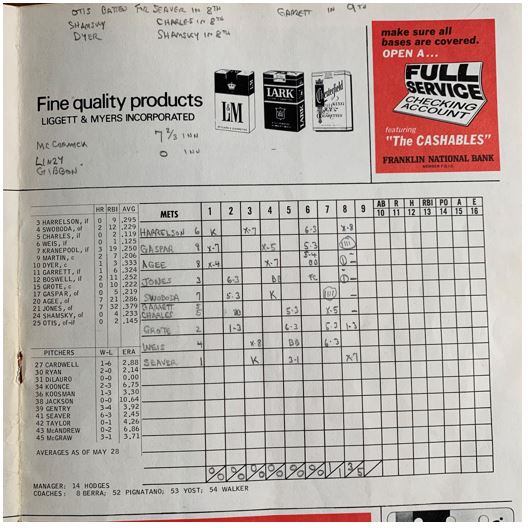
… The Mets cam back with four runs in the seventh eighth innings to pull out the win.
These were super fun to go through and to think about my Grandfather and how he would have kept these during the game. It also meant that much more to see Seaver as one of the pitchers given his passing. The other thing I thought about were how many great players you can see written in these books. It made me wonder how I will feel later on about some of the scorecards I have around.